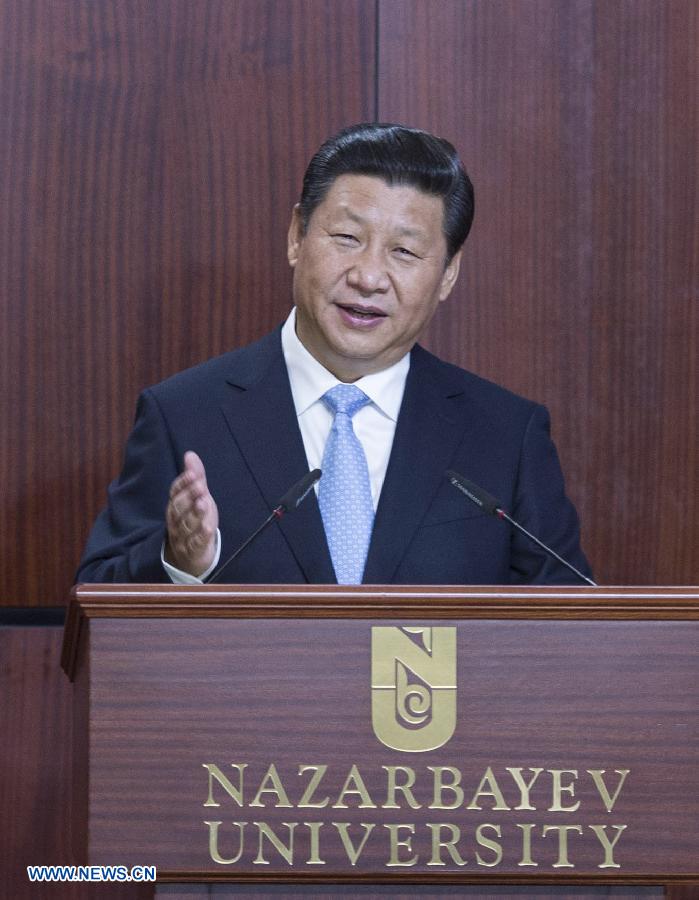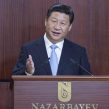
Future Scenarios on the New Silk Road: Security, Strategy and the SCO
Publication: China Brief Volume: 15 Issue: 6
By:

Chinese President Xi Jinping launched the “Silk Road Economic Belt” in a “historic” speech at Nazarbayev University in Kazakhstan in the week before the Shanghai Cooperation Organization (SCO) Summit in Kyrgyzstan in September 2013. The initiative was viewed by the rest of the region mostly through the lens of China’s “March West” policy (Indian Express, November 1, 2012). However, the Belt, which Xi envisions to span from “the Pacific Ocean to the Baltic Sea,” also represents a component of China’s growing strategic landpower in Eurasia (China Daily, September 8, 2013). Due to the multifaceted purposes that the Silk Road Economic Belt serves for China, it has now risen to the level of a “strategy.”
Insofar as a Net Assessment is concerned with long-term strategic trends, the Silk Road Economic Belt fosters infrastructure ties—railways, pipelines and roads—that permanently bind China to Central Asia in a way that neither the original Silk Road nor a maritime “String of Pearls” have done. These ties ensure China maintains an economic and, therefore, a political and military stake in the region to secure investments, improve relations between China and Russia, Afghanistan, Pakistan, India, Mongolia, Nepal, Bhutan and the Central Asian states that border Xinjiang, as well as develop the province itself. China’s military stake in Central Asia also requires various levels of collaboration between China and its neighbors, which is now most prominently carried out through the forum and mechanisms of the SCO.
The Ties that Bind
Economics and the SCO
The SCO, originally called the Shanghai Five, was founded in 1996 to demarcate China’s borders with its Central Asian neighbors. However, after demarcation was accomplished in the late 1990s (with the exception of the China-Tajikistan border, which was finally demarcated in 2011), the SCO focused mostly on regional security with the formation of the Regional Anti-Terror Structure (RATS) in 2004 (now based in Tashkent) and other joint exercises under the member states’ defense ministries, including “Peace-Mission 3” in 2005 with 10,000 Chinese and Russian troops. Although the first SCO ministerial-level meetings on trade and economics took place as early as 2002–2003, it was not until President Xi’s launch of the Silk Road Economic Belt before the SCO Summit in 2013 that the Organization could claim credit as a bonafide regional economic institution.
The landmark energy and infrastructure deals that Xi made with his Central Asian counterparts before the SCO Summit in September 2013 related to:
- The first phase of production at Turkmenistan’s “Galkynysh,” the world’s second largest gas field (Xinhua, September 3, 2013);
- A $5 billion stake in Kazakhstan’s Kashagan oil project in the Caspian Sea (Interfax, September 7, 2013);
- $15 billion worth of investments in the oil, gas and uranium sectors in Uzbekistan (Asia Times, September 23, 2013);
- A “strategic partnership” with Kyrgyzstan and funding of $3 billion in energy projects for the 225-kilometer Kyrgyzstan-China gas pipeline to pump gas from “Galkynysh” via Uzbekistan and Kyrgyzstan to Xinjiang (Xinhua, September 9, 2013); and
- The construction of Line D of the China-Central Asia gas pipeline, which links Tajikistan to Xinjiang (China Daily, September 13, 2013). [1]
While the Silk Road Economic Belt was announced on the sidelines—as opposed to within the structures—of the SCO summit, it was the SCO that provided the forum for President Xi to make and publicize these deals. From a cultural-business perspective, the SCO provided the setting that gave “face” to China, for whom the SCO has special meaning as the lone international organization that is named after a Chinese city—Shanghai. [2] Moreover, the pre-SCO summit deals marked the culmination of the progress of Chinese–Central Asian relations since the founding of the original Shanghai Five, which made Xi’s deals possible by removing a key barrier to trust between China and SCO member states through border demarcation.
Strategic Land Power and National Security
China’s growing economic influence and power along the Silk Road Economic Belt has several effects on China’s national security objectives. For example:
- The resources China imports from SCO countries, including Pakistan, which will enter the SCO along with India in 2015, are central to meeting China’s energy needs and diversifying, securing and expediting its energy imports. The China-run Gwadar Port in Pakistan, for example, reduces distances between East African and Persian Gulf ports to western China by more than four times the distance between eastern China and these regions via the Malacca Strait. And if Iran joins the SCO, which could only happen if United Nations sanctions on its nuclear program are dropped, then Iran’s Chabahar Port could play a similar role to Gwadar (Dawn, February 17, 2013).
- The economic development of Central Asia and Xinjiang is expected to enhance the well-being of the people of the region and reduce factors, such as unemployment, that contribute to youths joining militant movements that threaten China and Central Asian states (Global Times, May 6, 2014);
- Regional interdependence and integration will lead to closer ties between China and its Central Asian neighbors, which China can leverage to win their cooperation in preventing anti-Chinese militant groups from forming cells on Central Asian territory, which previously happened in the 1990s.
Foreign Policy Rationale
The Silk Road Economic Belt shows that the Chinese government has largely adopted scholar Wang Jisi’s proposal to “March West” (Global Times, October 17, 2012). This proposal was intended to reduce the pressure on China to extract resources from highly volatile zones like Sudan and Nigeria in Africa in favor of more stable regions like Central Asia. It also would reduce the potential for China to engage in “zero-sum” competition with the United States for supremacy in East Asia by allowing China to compete instead with a declining Russia and a United States that is withdrawing from Central Asia. In addition, while mid-level powers in East Asia, such as South Korea, Japan, Vietnam and Myanmar, are moving away from the historical Chinese political and cultural orbit in East Asia (not to mention Hong Kong and Taiwan), the political culture of Central Asia—with its one-party post-communist systems, though still no succession like in China—may provide more compatible terrain for China to operate on a diplomatic level. [3]
This, however, is not intended to over-estimate the importance of the Silk Road Economic Belt to Chinese foreign policy alone. While considered vital to China’s economic activities on the West Axis (Central Asia) and South Axis (Afghanistan-Pakistan), it is also essential for developing Xinjiang’s pipeline and oil refinery infrastructure and providing the jobs and economic benefits that come with this development in Xinjiang. As such, it can neither be seen strictly in military or economic terms nor in foreign policy or domestic terms, but rather as a combination of all of these aspects. Thus, it has, in essence, become so comprehensive as to warrant the label of a strategy—whether called “March West” or the “Silk Road Economic Belt.”
Managing Risk
Despite the ambitious and wide-ranging infrastructure projects that China is carrying out with SCO countries, there are significant internal socio-political trends and external terrorism and insurgency trends that could derail or pose risks to China’s projects.
The socio-political trends can be categorized according to three types:
- Simmering inter-ethnic issues in Central Asia that are rising to the surface as each state becomes more nationalistic in defining its own identity in juxtaposition to its neighbors, its Russian-influenced and communist past, as well as the growing Islamist movements on the region’s periphery, especially Iran, Afghanistan and Pakistan.
- Leadership succession, as three of Central Asia’s five presidents—Nursultan Nazarbayev of Kazakhstan, Islam Karimov of Uzbekistan and Emomali Rahmon of Tajikistan—have been in power continuously since their countries’ independence in 1991. While Kyrgyzstan’s coups in 2005 and 2010 have now led to an open parliamentary democracy, the country is less stable and as corrupt as any of its neighbors.
- The disparity in water resources between less wealthy but advantaged upstream countries (Tajikistan and Kyrgyzstan) and the three downstream neighbors (Kazakhstan, Uzbekistan and Turkmenistan) and the potential for water projects like the Rogun Dam in Tajikistan to lead to a broader conflict cannot be ruled out. [4]
External to the region, there are a number of threats related to terrorism and insurgency that could undermine the Silk Road Economic Belt vision.
- The Islamic State (IS) organization received a pledge of loyalty from factions of the Taliban and Islamic Movement of Uzbekistan (IMU)—the latter likely because it lost hundreds of Central Asian recruits to IS due to the popularity of the jihad in Syria and ease of travel to Syria via Turkey. IS may try to provoke Central Asia with an attack to propagandize its presence in “Wilayat Khorasan” (Afghanistan, Central Asia and Xinjiang). This is in contrast to the Taliban, which accepted the concept of the nation-state and came to an accommodation with Central Asian countries for diplomatic and economic reasons, and al-Qaeda, which saw relatively few “far enemy” targets in Central Asia and largely ignored the region (Fergana News, November 12, 2014).
- The “revival” of the Turkistan Islamic Party (TIP)—commonly referred to as the East Turkmenistan Islamist Movement (ETIM)—whose logistics bases in Turkey and connections to militants and supporters of IS and al-Qaeda-related factions in Syria and as far as Southeast Asia have grown as a result of the war in Syria. This increases the TIP’s potential to target Chinese interests abroad or connect with Uyghurs in Xinjiang, including through the Internet, by launching more of the types of suicide and car bombings that have characterized the budding insurgency in Xinjiang (and increasingly eastern China) since 2013 (see China Brief, May 23, 2014; The Star, September 18, 2014).
- The withdrawal of U.S. forces from Afghanistan in 2016, at a time when it is unclear whether the Afghan security forces will remain cohesive and committed in the face of a recharged Taliban, leaves open the possibility for continued instability and political discord in Afghanistan. This could present an opportunity for militants as well as other criminals and drug traffickers to create instability along the borderlands of Central Asia.
Conclusion
In a long-term calculation, such as a Net Assessment, it should be noted that China for much of its history was a continental—not maritime—power. Moreover, while Association of Southeast Asian Nations (ASEAN) states, the United States and its allies in East Asia seek to contain China, China is creating new norms and regional institutions in Central Asia, such as the SCO, to project power deeper into the Eurasian heartland largely uncontested and on its own terms. Considering China’s massive 1.4 billion population and the shorter routes between Xinjiang and energy resources in East Africa and the Persian Gulf, it will become increasingly important for China to become a landpower to secure its vital economic interests in Eurasia. While internal threats to the stability of Central Asia and external threats from non-state actors continue to grow, China’s assertiveness through the SCO and its tightening of relations with Pakistan and Iran suggest that China’s ambitions as a land power represent a strategy that extends beyond the currently defined “Central Asian” region.
Notes
- This deal was agreed on in Bishkek, Kyrgyzstan; President Xi did not visit Tajikistan in 2013.
- Shanghai has traditionally played second fiddle to Beijing in international affairs, although this trend may be changing with the SCO, World Expo in 2010 and the Conference on Interaction and Confidence-Building Measures in Asia (CICA) summit in 2014, all connected to Shanghai.
- Moreover, President Xi’s remarks while visiting Uzbekistan about his family roots in Shaanxi, a Chinese hub on the old Silk Road, and the name—Silk Road Economic Belt, which rivals the U.S.-proposed “New Silk Road”—suggests China is also trying play the “cultural card” in its relations with Central Asia.
- The Ili and Irtysh rivers in Xinjiang are also upstream of the border with Kazakhstan, which presents another potential source of conflict.





